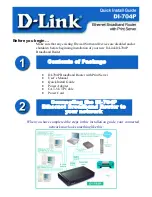
S
ECTION
4
L
INK
E
MULATION
T
AB
:
L
INK
E
MULATION
P
ARAMETER
C
ONFIGURATION
18
4.2.1 Queue Depth
The Queue Depth row specifies the maximum amount of data that will be buffered when data is
received at a rate exceeding the emulated link rate. Any frames that arrive when the queue is full
are discarded.
The queue depth can be set as a maximum numbers of packets, maximum amount of data in
kilobytes, or a maximum queuing delay in milliseconds. The queue depth is specified separately
for each direction. Valid entries are limited to 10,000 packets, KB, or milliseconds.
By default, the queue depth is set to 250ms. For most networks, this setting will lead to few
packet drops, but the queuing delay can reach 250ms in each direction. A smaller queue depth
will lead to a smaller maximum delay, but potentially more dropped packets. If possible, specify
the queue depth and units to match the queuing behavior of the WAN transmission equipment
on the network being emulated.
4.2.2 Framing Overhead
Framing overhead is the number of additional bytes required by a link-layer technology when
transmitting a packet of data. Typically, the framing overhead consists of link-layer addressing
and error checking information.
To emulate a link-layer technology with a particular framing overhead, select the value from the
drop-down list, if available, or choose C
ustom
and enter the specific value.
To emulate the traversal of a frame over a link, the Linktropy WAN Emulator calculates the
effective size of the frame as the data portion of the Ethernet frame (without the Ethernet header
or FCS) plus the specified framing overhead.
The Linktropy WAN Emulator includes three choices for framing overhead:
Ethernet ( FCS)
This option emulates a WAN link layer with an Ethernet-like frame of 18 bytes of header and
frame check sequence (FCS). This is the default option and is a reasonable choice if the
properties of the link layer are unknown.
Ethernet (header, FCS, preamble, pad)
This option emulates an actual Ethernet link, including the preamble and padding between
Ethernet frames. Select this option to emulate an Ethernet-based WAN network.
Custom
This option allows the specification of any link layer framing overhead in bytes per data
packet up to a maximum of 300 bytes. Select this option if the link layer framing overhead is
known.
















































